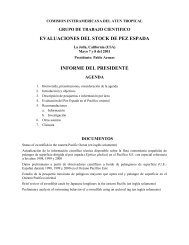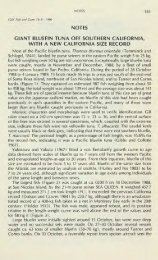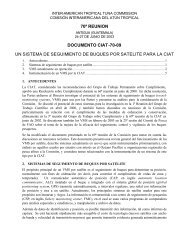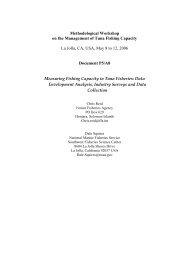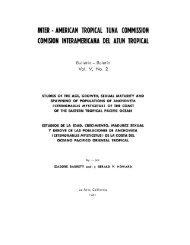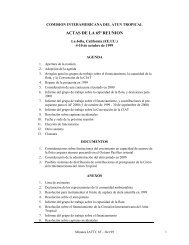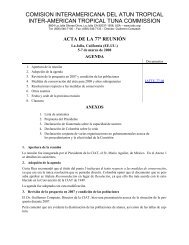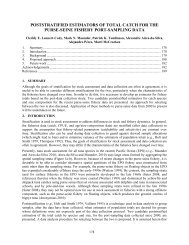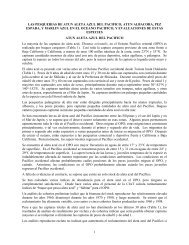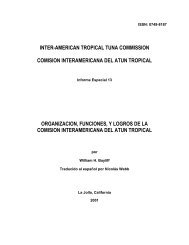t - Comisión Interamericana del Atún Tropical
t - Comisión Interamericana del Atún Tropical
t - Comisión Interamericana del Atún Tropical
- No tags were found...
Create successful ePaper yourself
Turn your PDF publications into a flip-book with our unique Google optimized e-Paper software.
CURRENTS IN PANAMA BAY413is, any profile lies somewhere between the t\VO simple topographies regardlessof what form it is. Most profiles are in fact approximately parabolicbut everywhere of small curvature, so that they more closely correspondwith the linear bottom profile. T'herefore there will be no significant differencesfrom expected depth-mean currents if for the purposes of calculationthe bottom in Panama Bay is assumed to have a uniform slope, andin fact this is assumed for the following discussion.For a simple ·harmonic tide the maximum rate of change of sea leveloccurs at the half-tides and is 1.57 times larger than the mean rate ofchange of sea level (range divided by duration). Values of the latter havealready been discussed with regard to inequalities between the fload andebb halves of the tidal cycle during the survey period (see Table 2). If itis assumed that eachhalf of a tidal cycle is harmonic, even though differencesbetween halves exist, then these data can be used with equation(11) to compute the maximum expected depth-mean currents during floodand ebb at each station. Equation (11) becomes- L RV max == 0.436 Ji ·15 m/secwith L in km, h and R in m, and duration D in hr. The expression is completeexcept for sign; current is taken to be positive during floods andnegative during ebbs. Although the relation is simple, prior knowledgeof the directions of the maximum tidal currents is re'quired before it canbe used. Without that knowledge only the lowest expected values of maximumtidal current can be computed at any position offshore, for L wouldthen be taken as the minimum distance to the shore. In such a case theonly data required are L and b from a chart and R and D from predictedtide tables.The flood-ebb direction in Panama Bay has already been establishedas 330° - 150 0 T. Using this fact the distance L for each station was measuredfrom a chart and, together with the corrected chart deptb h and themean rates of change of sea level (Table 2), used to calculate the expectedvalues of maximum depth-mean tidal curre,nt (Table 4). At Stations B,e and D these compare favorably with the "observed" maximum depthmeancurrents which were estimated by averaging the half-Iengths of themaximum dimension of the tidal current figures for all depths, but atStation A the expected value is about fifty per cent larger than the observedvalue and the reverse is true at Station E. There is a possibilitythat current at Station A is affected by the proximity of Taboguilla Islandso that shoreward of that station part of the water exchange during a tidalcycle could be from the northeast or south as well as along 330° - 150 0 T;then current at Station A would be weaker than expected. Why suchstrong currents were observed at Station E is not understood.As an application of these results, together with results from the discussionof net currents, the expected depth-mean currents were computed



